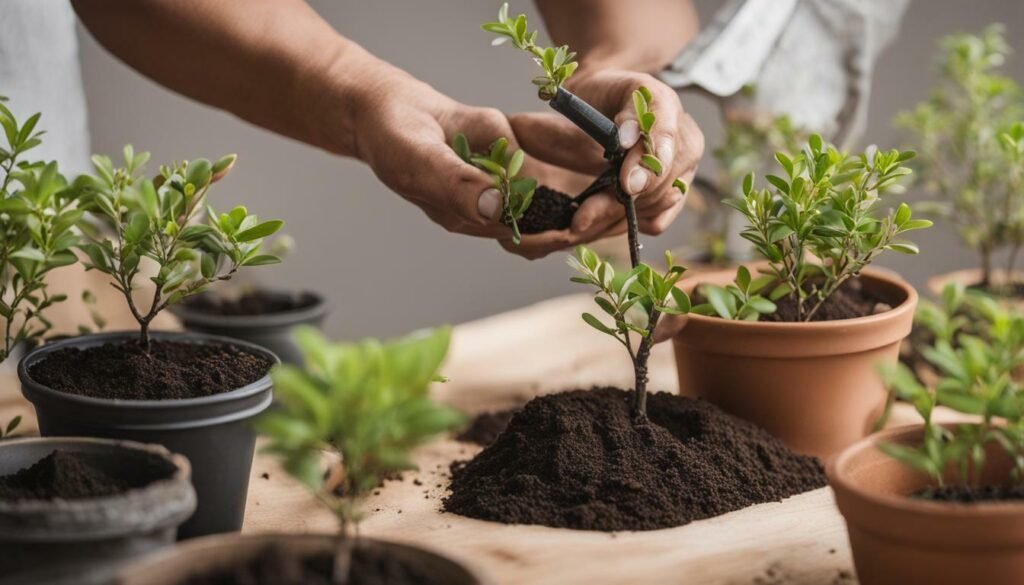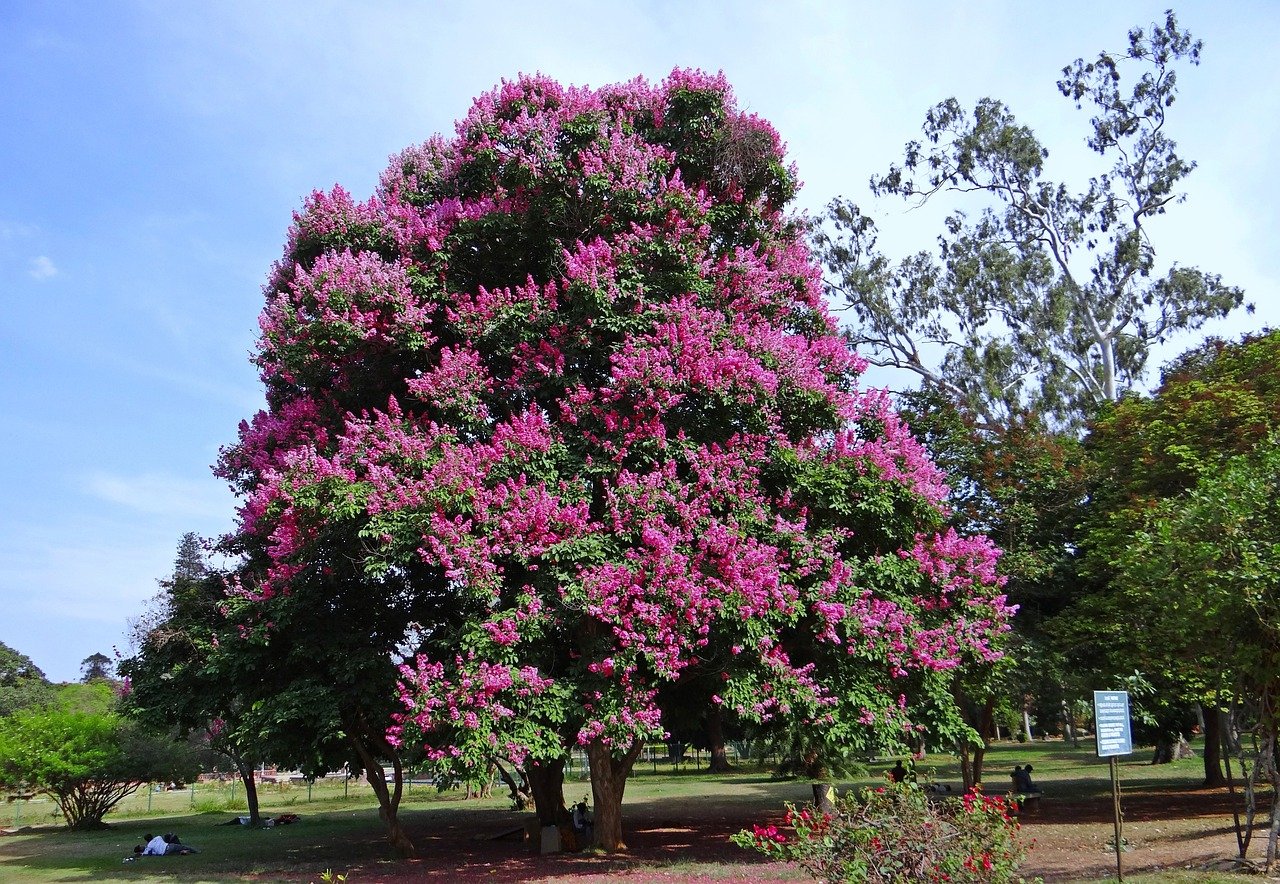Table of Contents
If you’re a fan of crepe myrtle trees and want to introduce a new plant to your garden, why not try growing one from seed? Not only is it an exciting project, but it’s also an easy and rewarding way to propagate crepe myrtle. In this article, we’ll walk you through the step-by-step process of growing a crape myrtle from seeds, from collecting the seed pods to sowing and nurturing the seedlings.
But first, let’s talk a little bit about crape myrtles. These shrubs and trees are known for their beautiful blooms in shades of pink, red, and purple, their colorful berries in the fall, and their vibrant foliage in the summer and fall. They are relatively easy to grow, and with the right care, you can enjoy their beauty for years to come.
So, if you’re ready to get started on growing your very own crape myrtle from seed, let’s dive in!
Key Takeaways:
- Growing a crape myrtle from seed is an exciting and rewarding project.
- Crape myrtles are known for their beautiful blooms, colorful berries, and vibrant foliage.
- With the right knowledge and care, you can enjoy your crape myrtle’s beauty for years to come.
Collecting and Preparing Crape Myrtle Seeds
The first step in growing a crape myrtle from seeds is to collect the seeds. The best time to collect the seeds is in the fall when they start to turn brown and dry. You can look for the seed pods hanging from the branches of the crepe myrtle trees.
Once you have collected the seed pods, gently open them to reveal the small brown seeds inside. Remove these seeds and lay them out to dry on a paper towel for a few days. When the seeds are dry, they are ready for germination.

It’s important to note that not all crepe myrtle seeds will produce a new plant. To increase your chances of success, collect as many seeds as possible.
Germinating Crape Myrtle Seeds
Now that you have collected the crape myrtle seeds, it’s time to move on to the germination process. There are several methods for germinating crepe myrtle seeds, and we will cover three of the most effective below:
- Stratification: This method involves placing the seeds in a container with damp sand or peat moss and leaving them in the refrigerator for several weeks. This simulates the winter dormancy period that the seeds would experience in nature and prepares them for germination. After the stratification period, remove the seeds from the refrigerator and place them in a warm location to germinate.
- Scarification: This method involves nicking the seed coat to allow water to penetrate into the seed. You can nick the seed coat with a sharp knife or sandpaper. After scarification, soak the seeds in warm water for a few hours to further promote germination.
- Soaking: This method involves soaking the seeds in warm water for 24-48 hours before planting. This softens the seed coat and allows water to penetrate, which promotes germination.
Regardless of the method you choose, make sure to place the seeds in a warm location with plenty of light. Keep the soil moist but not waterlogged, and you should start to see the seeds germinate in 1-2 weeks.
It’s important to note that not all crape myrtle seeds will germinate, and some may take longer than others. Be patient and continue to provide the right conditions for germination.
Sowing and Nurturing Crape Myrtle Seedlings
Now that your crape myrtle seeds have germinated, it’s time to sow them and nurture the seedlings. When the seedlings have developed their true leaves, it’s time to transplant them to a bigger pot or to the ground. To propagate crepe myrtle, follow these steps:
Step 1: Place the Seeds
Fill a pot or seed tray with potting soil and place the germinated seeds in the soil. The potting soil should be well-draining and slightly moist. Cover the seeds with a thin layer of soil and spray them with water using a spray bottle.
Step 2: Provide a Warm Location
Place the pot in a warm location that receives bright, indirect light. The temperature should be between 70-75°F to encourage the seedlings to grow. Cover the pot with a plastic wrap to retain moisture and increase humidity.
Step 3: Water the Seedlings
Keep the soil moist but not waterlogged. Use a spray bottle to water the seedlings to avoid dislodging them. Avoid watering the soil directly as it may cause the seeds to rot.
Step 4: Transplant the Seedlings
When the seedlings have grown to a few inches tall with a good root system, it’s time to transplant them to a bigger pot or to the ground. Be very careful when removing the seedlings from the pot to avoid damaging the roots. Plant them in a hole that is twice as wide as the root ball. Fill the hole with soil and press down gently around the base of the plant. Water thoroughly and add a layer of mulch around the plant to retain moisture.
By following these steps, you can grow a beautiful crepe myrtle from seed and enjoy a new plant in your garden.
Caring for Crape Myrtle Seedlings
Once your crape myrtle seedlings have sprouted and developed their true leaves, it’s important to provide them with adequate care to ensure healthy growth.
Watering the young plants deeply and regularly is essential. During hot summer months, you may need to water daily to prevent them from drying out. Fertilizing the seedlings with a balanced fertilizer can also promote healthy growth.
Make sure to provide your crape myrtle seedlings with the right conditions for their growth. They prefer full sun, but can tolerate some shade. Keep them in a warm location, sheltered from strong winds.
If you notice any pests or diseases on your crape myrtle, use an insecticidal soap or neem oil spray to control the problem. Prune off any dead or diseased branches to keep your plant healthy.
As your crape myrtle seedlings continue to grow, you may need to transplant them to a larger container or to their permanent location. Late spring or early summer is the best time to do this, before the leaves turn brown in the winter. When transplanting, gently loosen the roots and plant in well-draining soil, making sure the top of the root ball is level with the soil surface.
With proper care and attention, your crape myrtle seedlings can grow into beautiful shrubs and trees, adding color and vibrancy to your garden or landscape.
Transplanting Crape Myrtle Seedlings
Once your crape myrtle seedlings have grown too big for their initial planting location or pot, it’s time to transplant them to their permanent home. Late spring or early summer is the best time to transplant crape myrtle seedlings.
The first step is to choose a warm location with well-draining soil for the new planting. Dig a hole that is twice the size of the root ball and add some potting soil to the bottom. Carefully remove the seedling from its current pot or planting location, being sure to keep the soil around the roots intact.
Place the crape myrtle seedling into the hole, making sure that the top of the root ball is level with the ground. Fill in the hole with the potting soil and press it down firmly. Water the new plant thoroughly to help the soil settle around the roots.
It’s important to keep the newly transplanted crape myrtle seedling well-watered for the first few weeks to ensure its survival. As it grows, it will need less frequent watering. By late summer, the crape myrtle’s growth should have slowed down, and its leaves may start to turn brown and fall off. This is a sign that it’s entering dormancy and is preparing for the winter months ahead.

Transplanting crape myrtle seedlings can be a challenging process, but it’s an essential step to ensure the healthy growth of your new plant. With the right care and attention, your crape myrtle will thrive in its permanent location and provide beautiful blooms and colorful berries for years to come.
Caring for Crape Myrtle Seedlings
Once your crape myrtle seedlings have developed true leaves, it’s important to provide them with specific care to ensure healthy growth.
Watering:
Water your seedlings regularly to keep the soil moist but not soggy. Overwatering can cause the roots to rot, so be careful not to drown your plants. Use a spray bottle to mist the leaves, which can help keep the plants hydrated without adding too much moisture to the soil.
Fertilizing:
Feed your seedlings with a balanced fertilizer once every two weeks during the growing season. Avoid fertilizing during the winter months when the plant is dormant.
Light and Temperature:
Crape myrtle seedlings need plenty of light to grow properly. Place them in a warm location that receives six to eight hours of sunlight a day. Avoid exposing them to extreme heat or cold, which can cause the leaves to turn brown and fall off.
Pruning:
As your crape myrtle seedlings grow, you may need to prune them to encourage branching and thicker growth. Wait until the plants are at least six inches tall before pruning, and make clean cuts just above a leaf node.
With proper care, crape myrtle seedlings are easy to grow and can provide years of beauty as full-grown shrubs and trees. By the early spring, you will be rewarded with beautiful blooms and colorful berries.
FAQ
Q: Can I grow a crape myrtle from seeds?
A: Yes, you can grow a crape myrtle from seeds.
Q: How do I collect and prepare crape myrtle seeds?
A: To collect crape myrtle seeds, wait until the seed pods turn brown and harvest them. To prepare the seeds for germination, remove them from the pods and allow them to dry.
Q: How do I germinate crape myrtle seeds?
A: There are different methods for germinating crape myrtle seeds. You can soak them in water overnight or scarify the seeds to help with germination.
Q: How do I sow and nurture crape myrtle seedlings?
A: Sow the crape myrtle seeds in well-draining soil and keep them moist. Once the seedlings emerge, provide them with adequate sunlight and water regularly.
Q: How do I care for crape myrtle seedlings?
A: Care for crape myrtle seedlings by watering them regularly, fertilizing them during the growing season, and providing them with the proper growing conditions, such as full sun.
Q: When and how do I transplant crape myrtle seedlings?
A: Transplant crape myrtle seedlings in late spring or early summer to a permanent location. Prepare the root ball carefully and plant them in well-prepared soil.







